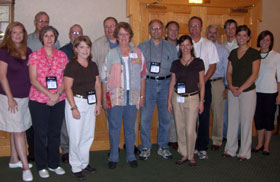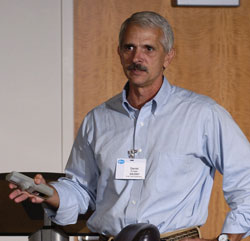 Right now Don Sauder, Pfizer Animal Health, VP, U.S. Cattle Operations is speaking about two new announcements involving the Pfizer SelectVAC preconditioning program. I’m going to interview him as soon as we break and post that later.
Right now Don Sauder, Pfizer Animal Health, VP, U.S. Cattle Operations is speaking about two new announcements involving the Pfizer SelectVAC preconditioning program. I’m going to interview him as soon as we break and post that later.
The first announcement is that Superior Livestock Auction has chosen SelectVAC as the preferred health program for calves sold through their auction. According to the announcement the partnership creates a new level of preconditioning that both organizations believe will help cow-calf producers get more value for their calves.
The second announcement involves the American Angus Association. The organization, along with Pfizer Animal Health are announcing a marketing alliance for two premier feeder calf programs. The collaboration pairs AngusSource, an age-, source- and genetic-USDA Process Verified Program (PVP) for Angus-sired cattle, with SelectVAC, from Pfizer Animal Health. According to the announcement more than 132,000 calves have been enrolled in AngusSource, nearly 51,000 in the first half of 2007.
More than 2.5 million calves have been enrolled in SelectVAC through its three flexible programs, PreVAC, WeanVAC and StockerVAC. Pfizer also announced today a reward for the 3 millionth enrollment in the program. Pfizer will mark the milestone by awarding that producer with a year’s worth of free SelectVAC products for their entire herd (up to a maximum of $5,000 in value). Calves must be enrolled in SelectVAC online to qualify, so visit SelectVAC.com for more information.
Post Update: Here’s my interview with Don Sauder right after this morning’s announcements: pfizer-vmrd-07-sauder.mp3

 Day two of the Pfizer Animal Health Media Event started out in a serious rain storm. I sure wish we’d had some of this back home.
Day two of the Pfizer Animal Health Media Event started out in a serious rain storm. I sure wish we’d had some of this back home. The outbreak of
The outbreak of  Here’s the guy who really showed us the way when it comes to BRD in cattle today at the Pfizer Animal Health VMRD facilities. He’s Dr. Dan Scruggs and his topic was the whole BRD complex. I know more about diseases I couldn’t pronounce before today than I’ve got time to write about tonight. Let’s just say there are a number causes for bovine respiratory disease and Pfizer has some relatively new products to treat them with
Here’s the guy who really showed us the way when it comes to BRD in cattle today at the Pfizer Animal Health VMRD facilities. He’s Dr. Dan Scruggs and his topic was the whole BRD complex. I know more about diseases I couldn’t pronounce before today than I’ve got time to write about tonight. Let’s just say there are a number causes for bovine respiratory disease and Pfizer has some relatively new products to treat them with
 The Pfizer Animal Health marketing manager for Draxxin is Dave Korbelik. He was our emcee today and introduced our speakers while also contributing some interesting information about Pfizer products.
The Pfizer Animal Health marketing manager for Draxxin is Dave Korbelik. He was our emcee today and introduced our speakers while also contributing some interesting information about Pfizer products. Here’s our group of agricultural journalists at rapt attention today at the Pfizer Animal Health Veterinary Medicine Research and Development facilities. Although we sat in a meeting room most of the day we did get a break to go into a wet lab. Tomorrow its a tour around the farm as described below.
Here’s our group of agricultural journalists at rapt attention today at the Pfizer Animal Health Veterinary Medicine Research and Development facilities. Although we sat in a meeting room most of the day we did get a break to go into a wet lab. Tomorrow its a tour around the farm as described below. Wow. What a day. Talk about getting to know more about a company and their products. That’s what we got to do at Pfizer Animal Health VMRD Headquarters today. Before heading out there we did have our news conference here at
Wow. What a day. Talk about getting to know more about a company and their products. That’s what we got to do at Pfizer Animal Health VMRD Headquarters today. Before heading out there we did have our news conference here at  I’ll get more into what we learned soon but I just have to tell you how beautiful this place is. I want to stay for about a week.
I’ll get more into what we learned soon but I just have to tell you how beautiful this place is. I want to stay for about a week. Right now Don Sauder,
Right now Don Sauder,